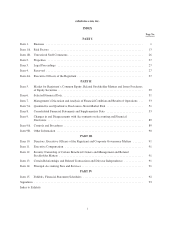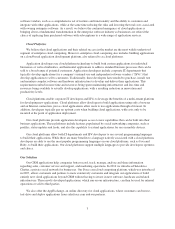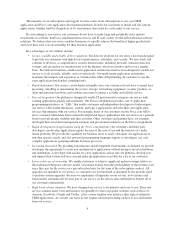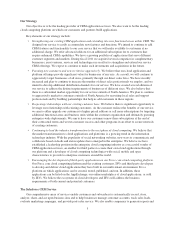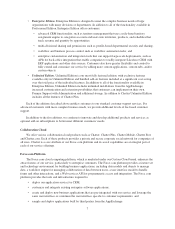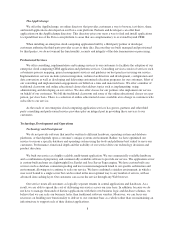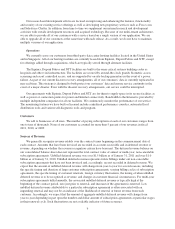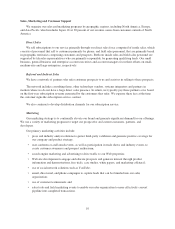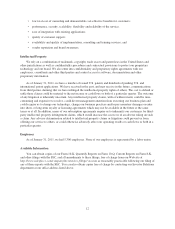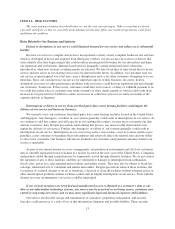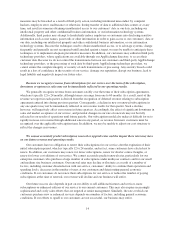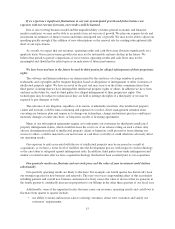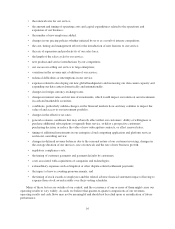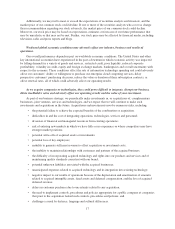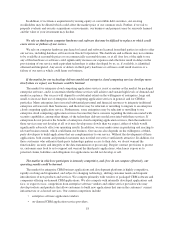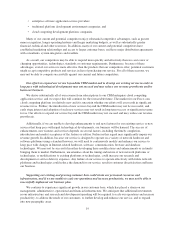Salesforce.com 2011 Annual Report Download - page 17
Download and view the complete annual report
Please find page 17 of the 2011 Salesforce.com annual report below. You can navigate through the pages in the report by either clicking on the pages listed below, or by using the keyword search tool below to find specific information within the annual report.Our research and development efforts are focused on improving and enhancing the features, functionality
and security of our existing service offerings as well as developing new proprietary services such as Force.com
and Salesforce Chatter. In addition, from time to time we supplement our internal research and development
activities with outside development resources and acquired technology. Because of our multi-tenant architecture,
we are able to provide all of our customers with a service based on a single version of our application. We are
able to upgrade all of our customers at the same time with each release. As a result, we do not have to maintain
multiple versions of our application.
Operations
We currently serve our customers from third-party data center hosting facilities located in the United States
and in Singapore. All of our hosting facilities are currently leased from Equinix, Dupont Fabros and NTT, except
for offerings added through acquisitions, which are typically served through alternate facilities.
The Equinix, Dupont Fabros and NTT facilities are built to the same critical systems building codes as
hospitals and other vital infrastructure. The facilities are secured by around-the-clock guards; biometric access
screening and escort controlled access, and are supported by on-site backup generators in the event of a power
failure. As part of our current disaster recovery arrangements, all of our customers’ data is currently replicated in
near real-time. This strategy is designed to both protect our customers’ data and ensure service continuity in the
event of a major disaster. Even with the disaster recovery arrangements, our service could be interrupted.
Our agreements with Equinix, Dupont Fabros and NTT are for them to supply space in its secure facilities as
well as power or connection points for power and Internet connectivity. Bandwidth to the Internet is provided by
multiple independent companies for all our facilities. We continuously monitor the performance of our service.
The monitoring features we have built or licensed include centralized performance consoles, automated load
distribution tools and various self-diagnostic tools and program.
Customers
We sell to businesses of all sizes. The number of paying subscriptions at each of our customers ranges from
one to tens of thousands. None of our customers accounted for more than 5 percent of our revenues in fiscal
2011, 2010, or 2009.
Sources of Revenue
We generally recognize revenue ratably over the contract terms beginning on the commencement date of
each contract. Amounts that have been invoiced are recorded in accounts receivable and in deferred revenue or
revenue, depending on whether the revenue recognition criteria have been met. The deferred revenue balance on
our consolidated balance sheet does not represent the total contract value of annual or multi-year, non-cancelable
subscription agreements. Unbilled deferred revenue was over $1.5 billion as of January 31, 2011 and over $1.0
billion as of January 31, 2010. Unbilled deferred revenue represents future billings under our non-cancelable
subscription agreements that have not been invoiced and, accordingly, are not recorded in deferred revenue. We
expect that the amount of unbilled deferred revenue will change from year-to-year for several reasons, including
the specific timing and duration of large customer subscription agreements, varying billing cycles of subscription
agreements, the specific timing of customer renewals, foreign currency fluctuations, the timing of when unbilled
deferred revenue is to be recognized as revenue, and changes in customer financial circumstances. For multi-year
subscription agreements billed annually, the associated unbilled deferred revenue is typically high at the
beginning of the contract period, zero just prior to renewal, and increases if the agreement is renewed. Low
unbilled deferred revenue attributable to a particular subscription agreement is often associated with an
impending renewal and may not be an indicator of the likelihood of renewal or future revenue from such
customer. Accordingly, we expect that the amount of aggregate unbilled deferred revenue will change from
year-to-year depending in part upon the number and dollar amount of subscription agreements at particular stages
in their renewal cycle. Such fluctuations are not a reliable indicator of future revenues.
9


